Monopoly & Monopolistic Competition in Australia
VerifiedAdded on 2023/06/07
|10
|2512
|473
AI Summary
The report discusses the market structures of monopoly and monopolistic competition in Australia. It explains the theoretical underpinnings of these structures and highlights the inefficiencies and government interventions required. The report also provides examples of monopolistic competition and monopoly in Australia.
Contribute Materials
Your contribution can guide someone’s learning journey. Share your
documents today.
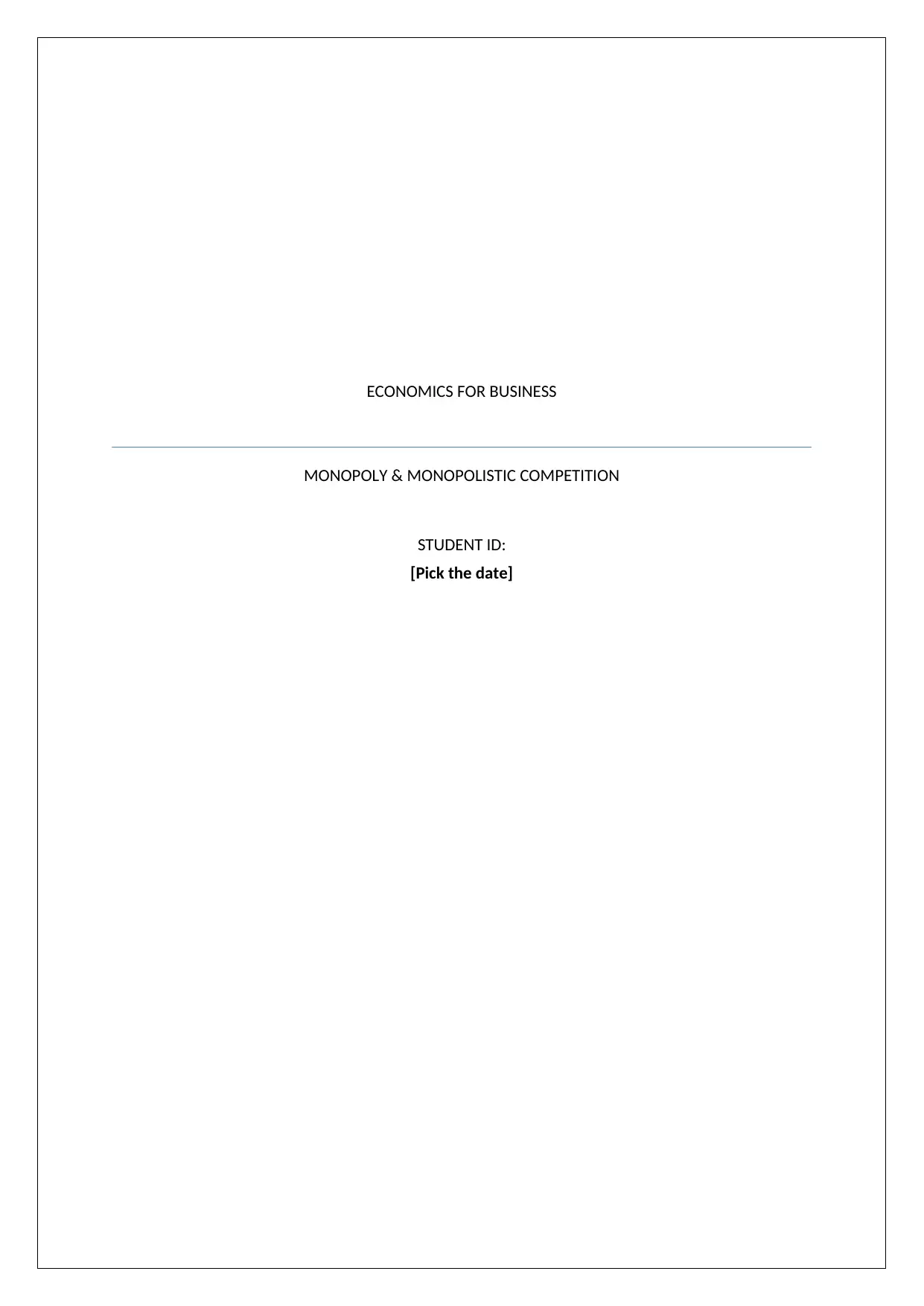
ECONOMICS FOR BUSINESS
MONOPOLY & MONOPOLISTIC COMPETITION
STUDENT ID:
[Pick the date]
MONOPOLY & MONOPOLISTIC COMPETITION
STUDENT ID:
[Pick the date]
Secure Best Marks with AI Grader
Need help grading? Try our AI Grader for instant feedback on your assignments.
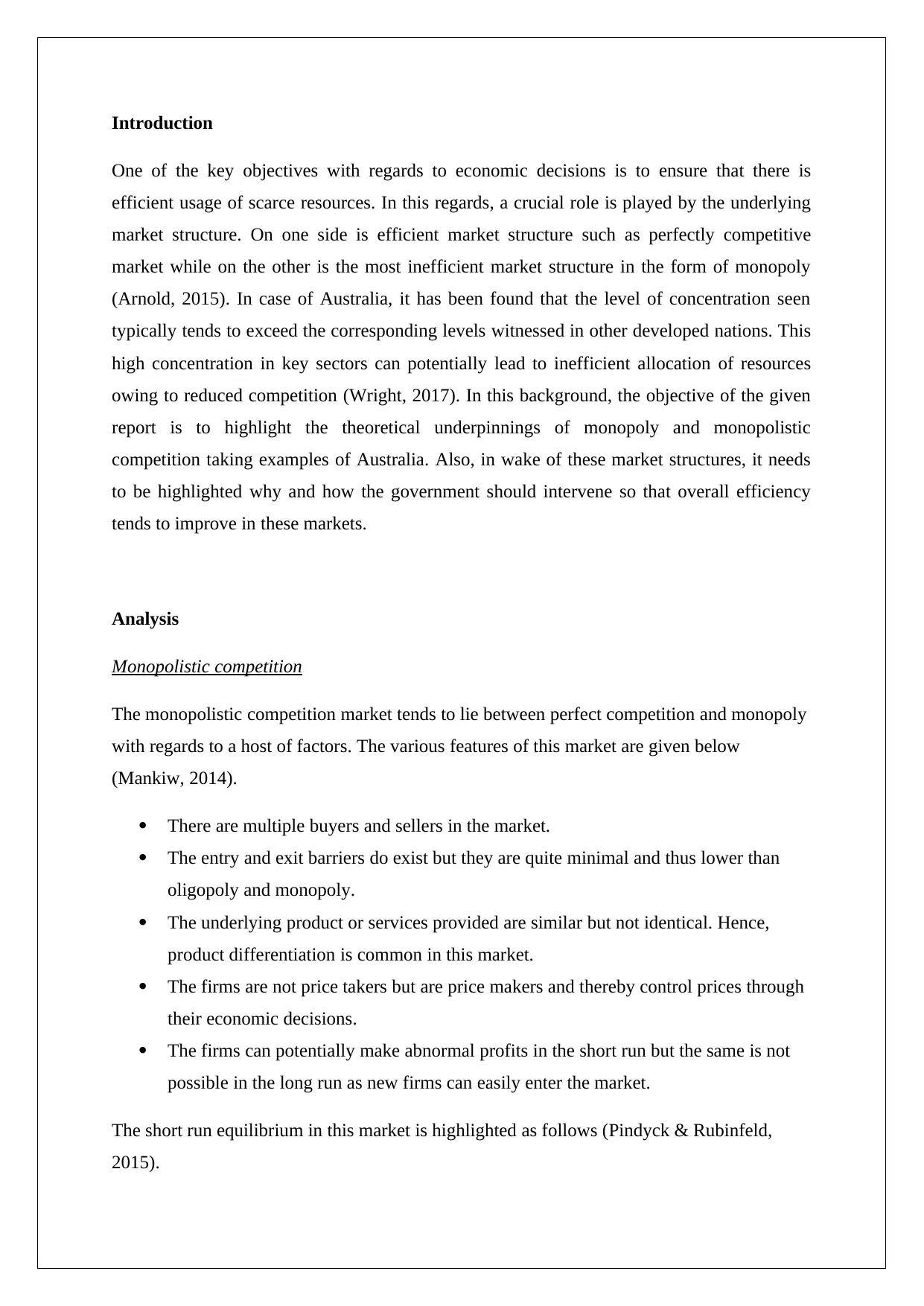
Introduction
One of the key objectives with regards to economic decisions is to ensure that there is
efficient usage of scarce resources. In this regards, a crucial role is played by the underlying
market structure. On one side is efficient market structure such as perfectly competitive
market while on the other is the most inefficient market structure in the form of monopoly
(Arnold, 2015). In case of Australia, it has been found that the level of concentration seen
typically tends to exceed the corresponding levels witnessed in other developed nations. This
high concentration in key sectors can potentially lead to inefficient allocation of resources
owing to reduced competition (Wright, 2017). In this background, the objective of the given
report is to highlight the theoretical underpinnings of monopoly and monopolistic
competition taking examples of Australia. Also, in wake of these market structures, it needs
to be highlighted why and how the government should intervene so that overall efficiency
tends to improve in these markets.
Analysis
Monopolistic competition
The monopolistic competition market tends to lie between perfect competition and monopoly
with regards to a host of factors. The various features of this market are given below
(Mankiw, 2014).
There are multiple buyers and sellers in the market.
The entry and exit barriers do exist but they are quite minimal and thus lower than
oligopoly and monopoly.
The underlying product or services provided are similar but not identical. Hence,
product differentiation is common in this market.
The firms are not price takers but are price makers and thereby control prices through
their economic decisions.
The firms can potentially make abnormal profits in the short run but the same is not
possible in the long run as new firms can easily enter the market.
The short run equilibrium in this market is highlighted as follows (Pindyck & Rubinfeld,
2015).
One of the key objectives with regards to economic decisions is to ensure that there is
efficient usage of scarce resources. In this regards, a crucial role is played by the underlying
market structure. On one side is efficient market structure such as perfectly competitive
market while on the other is the most inefficient market structure in the form of monopoly
(Arnold, 2015). In case of Australia, it has been found that the level of concentration seen
typically tends to exceed the corresponding levels witnessed in other developed nations. This
high concentration in key sectors can potentially lead to inefficient allocation of resources
owing to reduced competition (Wright, 2017). In this background, the objective of the given
report is to highlight the theoretical underpinnings of monopoly and monopolistic
competition taking examples of Australia. Also, in wake of these market structures, it needs
to be highlighted why and how the government should intervene so that overall efficiency
tends to improve in these markets.
Analysis
Monopolistic competition
The monopolistic competition market tends to lie between perfect competition and monopoly
with regards to a host of factors. The various features of this market are given below
(Mankiw, 2014).
There are multiple buyers and sellers in the market.
The entry and exit barriers do exist but they are quite minimal and thus lower than
oligopoly and monopoly.
The underlying product or services provided are similar but not identical. Hence,
product differentiation is common in this market.
The firms are not price takers but are price makers and thereby control prices through
their economic decisions.
The firms can potentially make abnormal profits in the short run but the same is not
possible in the long run as new firms can easily enter the market.
The short run equilibrium in this market is highlighted as follows (Pindyck & Rubinfeld,
2015).

In the above case, it is apparent that the optimal production level for profit maximisation is
decided by equating MR=MC. Using the intersection of the two curves, the equilibrium
quantity Q1 is obtained. Further, the price charged by the producers is P1 which is derived
from the demand curve. It is apparent from the above diagram that monopolistic firms can
potentially make supernormal profit in the short run (Krugman & Wells, 2014).
However, in the long run, owing to existence of low entry barriers, new firms would enter
which would enhance the supply and lead to increased competition which in turn would lead
to lower profits as is exhibited below (Mankiw, Mankiw & Taylor, 2011).
It is apparent that the profits have declined owing to shift in the demand curve. Another
noteworthy aspect is that at the equilibrium position, the average cost curve is not at the
bottom-most point which implies that in terms of productive efficiency, this market structure
decided by equating MR=MC. Using the intersection of the two curves, the equilibrium
quantity Q1 is obtained. Further, the price charged by the producers is P1 which is derived
from the demand curve. It is apparent from the above diagram that monopolistic firms can
potentially make supernormal profit in the short run (Krugman & Wells, 2014).
However, in the long run, owing to existence of low entry barriers, new firms would enter
which would enhance the supply and lead to increased competition which in turn would lead
to lower profits as is exhibited below (Mankiw, Mankiw & Taylor, 2011).
It is apparent that the profits have declined owing to shift in the demand curve. Another
noteworthy aspect is that at the equilibrium position, the average cost curve is not at the
bottom-most point which implies that in terms of productive efficiency, this market structure
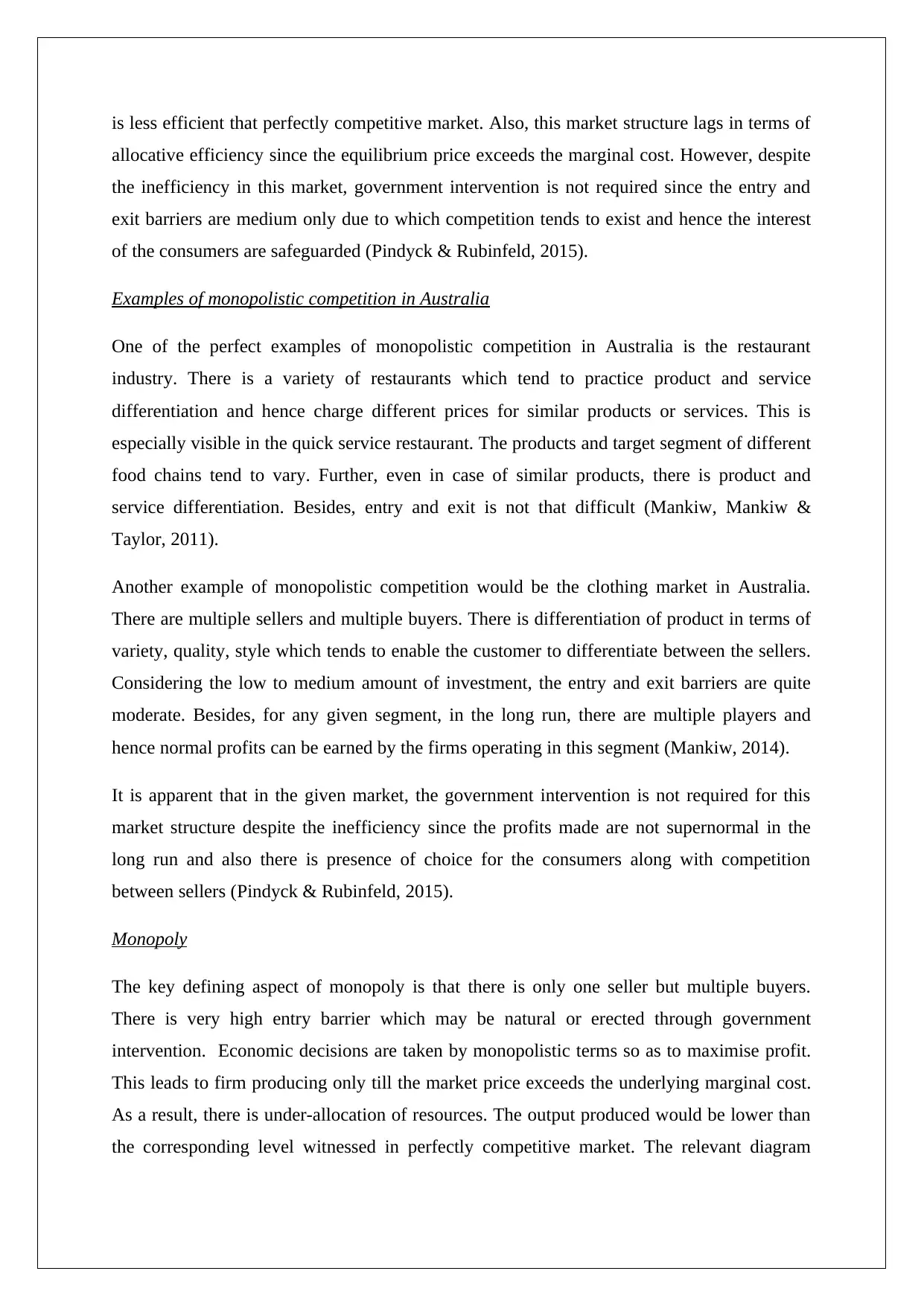
is less efficient that perfectly competitive market. Also, this market structure lags in terms of
allocative efficiency since the equilibrium price exceeds the marginal cost. However, despite
the inefficiency in this market, government intervention is not required since the entry and
exit barriers are medium only due to which competition tends to exist and hence the interest
of the consumers are safeguarded (Pindyck & Rubinfeld, 2015).
Examples of monopolistic competition in Australia
One of the perfect examples of monopolistic competition in Australia is the restaurant
industry. There is a variety of restaurants which tend to practice product and service
differentiation and hence charge different prices for similar products or services. This is
especially visible in the quick service restaurant. The products and target segment of different
food chains tend to vary. Further, even in case of similar products, there is product and
service differentiation. Besides, entry and exit is not that difficult (Mankiw, Mankiw &
Taylor, 2011).
Another example of monopolistic competition would be the clothing market in Australia.
There are multiple sellers and multiple buyers. There is differentiation of product in terms of
variety, quality, style which tends to enable the customer to differentiate between the sellers.
Considering the low to medium amount of investment, the entry and exit barriers are quite
moderate. Besides, for any given segment, in the long run, there are multiple players and
hence normal profits can be earned by the firms operating in this segment (Mankiw, 2014).
It is apparent that in the given market, the government intervention is not required for this
market structure despite the inefficiency since the profits made are not supernormal in the
long run and also there is presence of choice for the consumers along with competition
between sellers (Pindyck & Rubinfeld, 2015).
Monopoly
The key defining aspect of monopoly is that there is only one seller but multiple buyers.
There is very high entry barrier which may be natural or erected through government
intervention. Economic decisions are taken by monopolistic terms so as to maximise profit.
This leads to firm producing only till the market price exceeds the underlying marginal cost.
As a result, there is under-allocation of resources. The output produced would be lower than
the corresponding level witnessed in perfectly competitive market. The relevant diagram
allocative efficiency since the equilibrium price exceeds the marginal cost. However, despite
the inefficiency in this market, government intervention is not required since the entry and
exit barriers are medium only due to which competition tends to exist and hence the interest
of the consumers are safeguarded (Pindyck & Rubinfeld, 2015).
Examples of monopolistic competition in Australia
One of the perfect examples of monopolistic competition in Australia is the restaurant
industry. There is a variety of restaurants which tend to practice product and service
differentiation and hence charge different prices for similar products or services. This is
especially visible in the quick service restaurant. The products and target segment of different
food chains tend to vary. Further, even in case of similar products, there is product and
service differentiation. Besides, entry and exit is not that difficult (Mankiw, Mankiw &
Taylor, 2011).
Another example of monopolistic competition would be the clothing market in Australia.
There are multiple sellers and multiple buyers. There is differentiation of product in terms of
variety, quality, style which tends to enable the customer to differentiate between the sellers.
Considering the low to medium amount of investment, the entry and exit barriers are quite
moderate. Besides, for any given segment, in the long run, there are multiple players and
hence normal profits can be earned by the firms operating in this segment (Mankiw, 2014).
It is apparent that in the given market, the government intervention is not required for this
market structure despite the inefficiency since the profits made are not supernormal in the
long run and also there is presence of choice for the consumers along with competition
between sellers (Pindyck & Rubinfeld, 2015).
Monopoly
The key defining aspect of monopoly is that there is only one seller but multiple buyers.
There is very high entry barrier which may be natural or erected through government
intervention. Economic decisions are taken by monopolistic terms so as to maximise profit.
This leads to firm producing only till the market price exceeds the underlying marginal cost.
As a result, there is under-allocation of resources. The output produced would be lower than
the corresponding level witnessed in perfectly competitive market. The relevant diagram
Secure Best Marks with AI Grader
Need help grading? Try our AI Grader for instant feedback on your assignments.
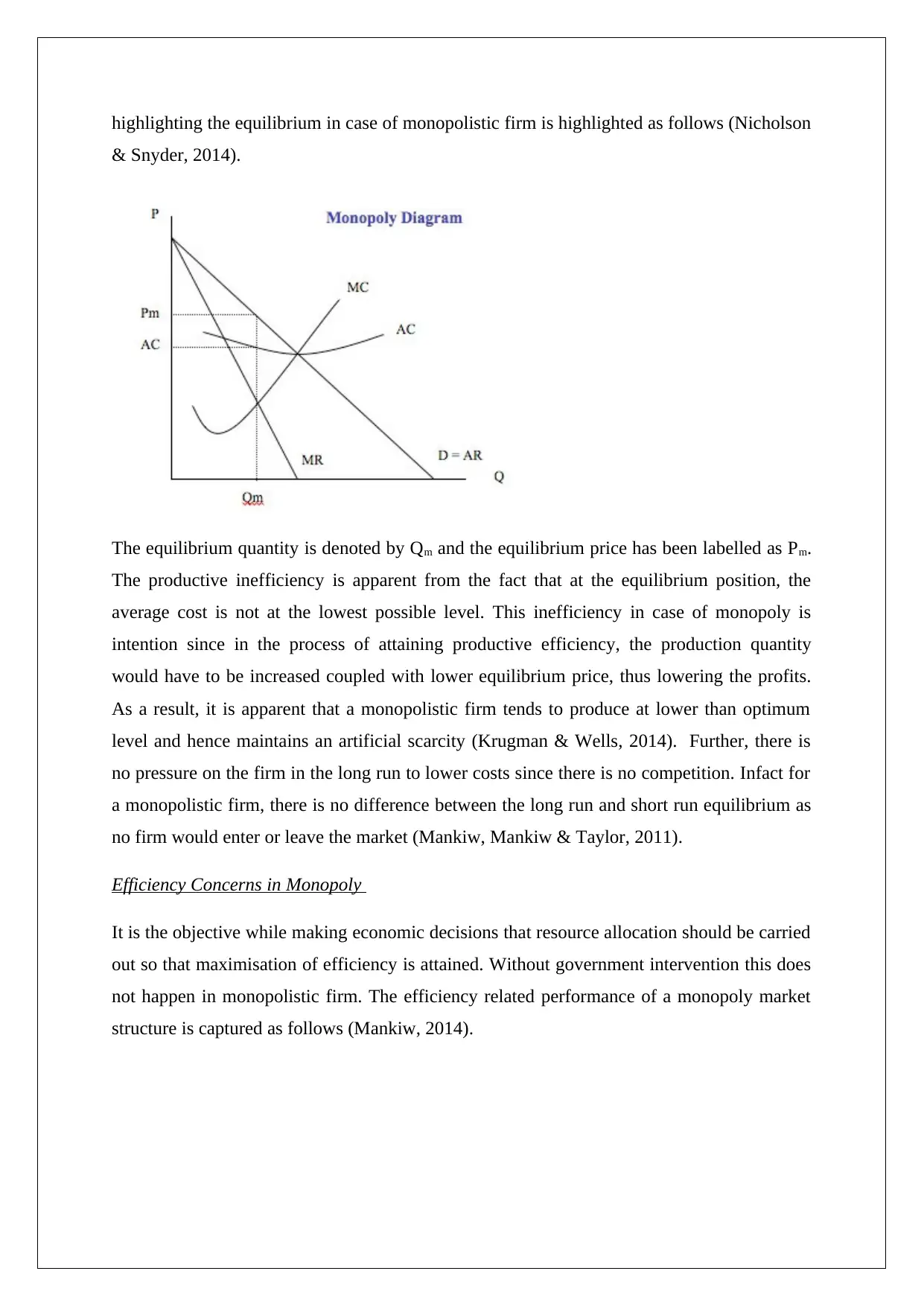
highlighting the equilibrium in case of monopolistic firm is highlighted as follows (Nicholson
& Snyder, 2014).
The equilibrium quantity is denoted by Qm and the equilibrium price has been labelled as Pm.
The productive inefficiency is apparent from the fact that at the equilibrium position, the
average cost is not at the lowest possible level. This inefficiency in case of monopoly is
intention since in the process of attaining productive efficiency, the production quantity
would have to be increased coupled with lower equilibrium price, thus lowering the profits.
As a result, it is apparent that a monopolistic firm tends to produce at lower than optimum
level and hence maintains an artificial scarcity (Krugman & Wells, 2014). Further, there is
no pressure on the firm in the long run to lower costs since there is no competition. Infact for
a monopolistic firm, there is no difference between the long run and short run equilibrium as
no firm would enter or leave the market (Mankiw, Mankiw & Taylor, 2011).
Efficiency Concerns in Monopoly
It is the objective while making economic decisions that resource allocation should be carried
out so that maximisation of efficiency is attained. Without government intervention this does
not happen in monopolistic firm. The efficiency related performance of a monopoly market
structure is captured as follows (Mankiw, 2014).
& Snyder, 2014).
The equilibrium quantity is denoted by Qm and the equilibrium price has been labelled as Pm.
The productive inefficiency is apparent from the fact that at the equilibrium position, the
average cost is not at the lowest possible level. This inefficiency in case of monopoly is
intention since in the process of attaining productive efficiency, the production quantity
would have to be increased coupled with lower equilibrium price, thus lowering the profits.
As a result, it is apparent that a monopolistic firm tends to produce at lower than optimum
level and hence maintains an artificial scarcity (Krugman & Wells, 2014). Further, there is
no pressure on the firm in the long run to lower costs since there is no competition. Infact for
a monopolistic firm, there is no difference between the long run and short run equilibrium as
no firm would enter or leave the market (Mankiw, Mankiw & Taylor, 2011).
Efficiency Concerns in Monopoly
It is the objective while making economic decisions that resource allocation should be carried
out so that maximisation of efficiency is attained. Without government intervention this does
not happen in monopolistic firm. The efficiency related performance of a monopoly market
structure is captured as follows (Mankiw, 2014).
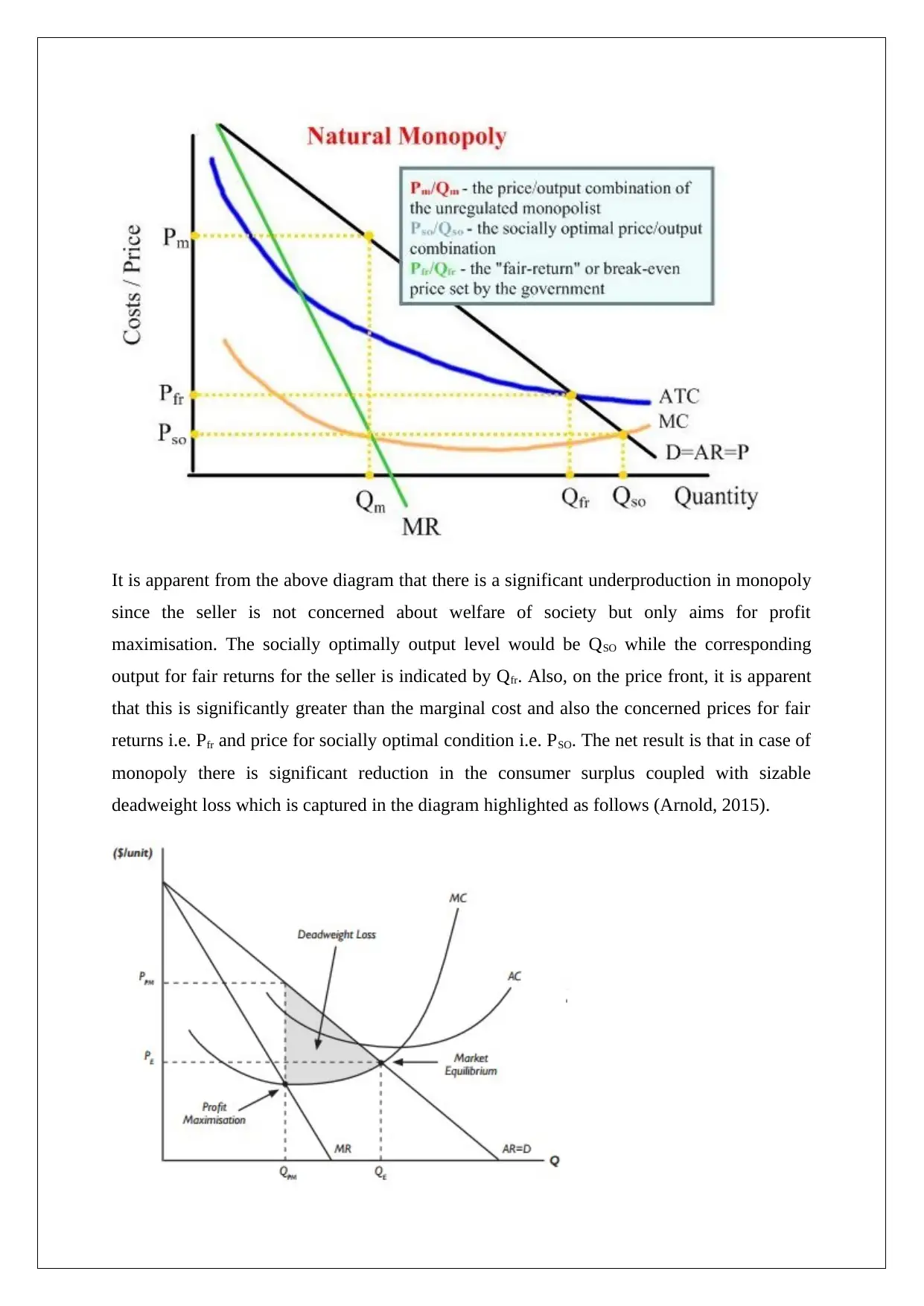
It is apparent from the above diagram that there is a significant underproduction in monopoly
since the seller is not concerned about welfare of society but only aims for profit
maximisation. The socially optimally output level would be QSO while the corresponding
output for fair returns for the seller is indicated by Qfr. Also, on the price front, it is apparent
that this is significantly greater than the marginal cost and also the concerned prices for fair
returns i.e. Pfr and price for socially optimal condition i.e. PSO. The net result is that in case of
monopoly there is significant reduction in the consumer surplus coupled with sizable
deadweight loss which is captured in the diagram highlighted as follows (Arnold, 2015).
since the seller is not concerned about welfare of society but only aims for profit
maximisation. The socially optimally output level would be QSO while the corresponding
output for fair returns for the seller is indicated by Qfr. Also, on the price front, it is apparent
that this is significantly greater than the marginal cost and also the concerned prices for fair
returns i.e. Pfr and price for socially optimal condition i.e. PSO. The net result is that in case of
monopoly there is significant reduction in the consumer surplus coupled with sizable
deadweight loss which is captured in the diagram highlighted as follows (Arnold, 2015).
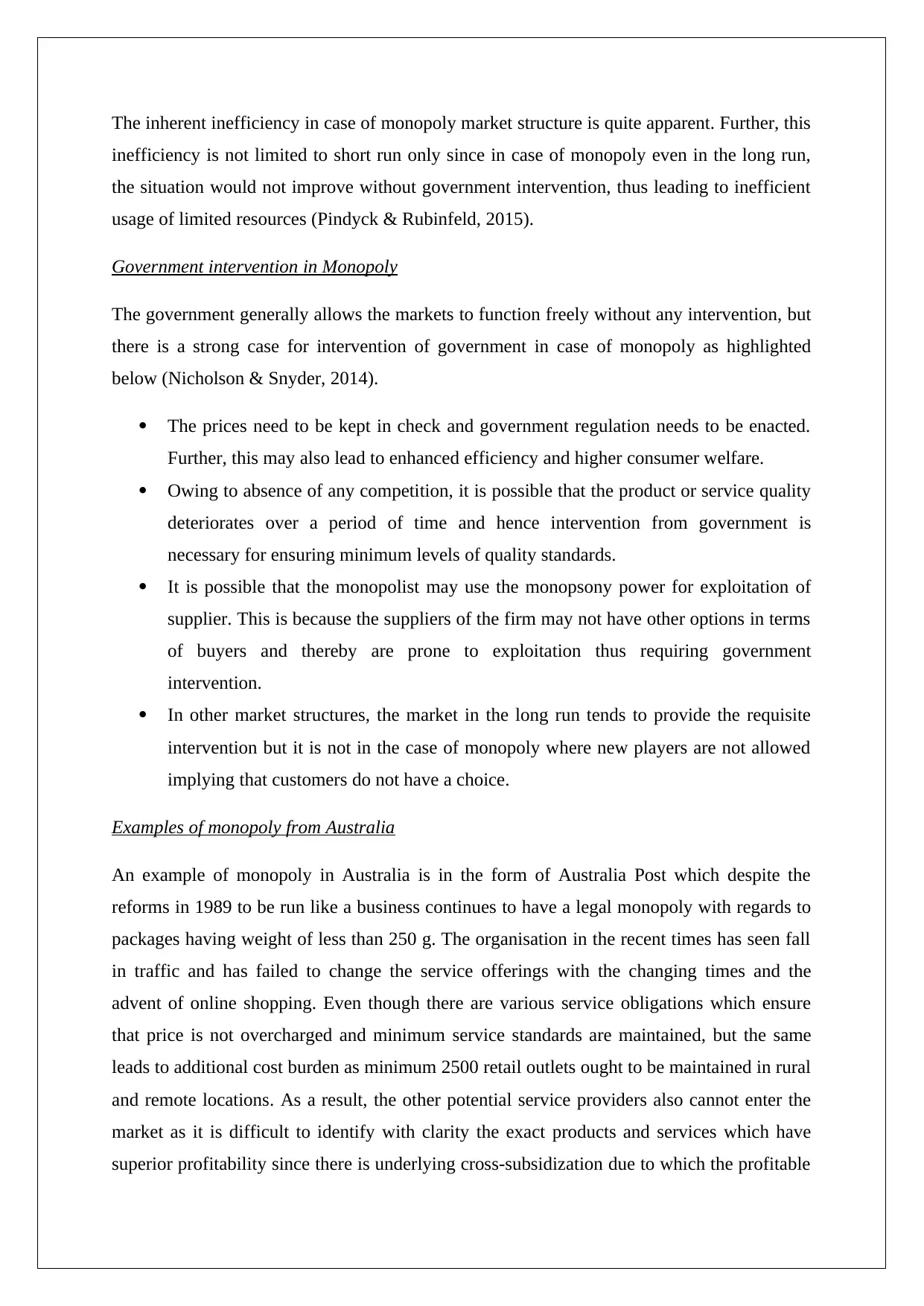
The inherent inefficiency in case of monopoly market structure is quite apparent. Further, this
inefficiency is not limited to short run only since in case of monopoly even in the long run,
the situation would not improve without government intervention, thus leading to inefficient
usage of limited resources (Pindyck & Rubinfeld, 2015).
Government intervention in Monopoly
The government generally allows the markets to function freely without any intervention, but
there is a strong case for intervention of government in case of monopoly as highlighted
below (Nicholson & Snyder, 2014).
The prices need to be kept in check and government regulation needs to be enacted.
Further, this may also lead to enhanced efficiency and higher consumer welfare.
Owing to absence of any competition, it is possible that the product or service quality
deteriorates over a period of time and hence intervention from government is
necessary for ensuring minimum levels of quality standards.
It is possible that the monopolist may use the monopsony power for exploitation of
supplier. This is because the suppliers of the firm may not have other options in terms
of buyers and thereby are prone to exploitation thus requiring government
intervention.
In other market structures, the market in the long run tends to provide the requisite
intervention but it is not in the case of monopoly where new players are not allowed
implying that customers do not have a choice.
Examples of monopoly from Australia
An example of monopoly in Australia is in the form of Australia Post which despite the
reforms in 1989 to be run like a business continues to have a legal monopoly with regards to
packages having weight of less than 250 g. The organisation in the recent times has seen fall
in traffic and has failed to change the service offerings with the changing times and the
advent of online shopping. Even though there are various service obligations which ensure
that price is not overcharged and minimum service standards are maintained, but the same
leads to additional cost burden as minimum 2500 retail outlets ought to be maintained in rural
and remote locations. As a result, the other potential service providers also cannot enter the
market as it is difficult to identify with clarity the exact products and services which have
superior profitability since there is underlying cross-subsidization due to which the profitable
inefficiency is not limited to short run only since in case of monopoly even in the long run,
the situation would not improve without government intervention, thus leading to inefficient
usage of limited resources (Pindyck & Rubinfeld, 2015).
Government intervention in Monopoly
The government generally allows the markets to function freely without any intervention, but
there is a strong case for intervention of government in case of monopoly as highlighted
below (Nicholson & Snyder, 2014).
The prices need to be kept in check and government regulation needs to be enacted.
Further, this may also lead to enhanced efficiency and higher consumer welfare.
Owing to absence of any competition, it is possible that the product or service quality
deteriorates over a period of time and hence intervention from government is
necessary for ensuring minimum levels of quality standards.
It is possible that the monopolist may use the monopsony power for exploitation of
supplier. This is because the suppliers of the firm may not have other options in terms
of buyers and thereby are prone to exploitation thus requiring government
intervention.
In other market structures, the market in the long run tends to provide the requisite
intervention but it is not in the case of monopoly where new players are not allowed
implying that customers do not have a choice.
Examples of monopoly from Australia
An example of monopoly in Australia is in the form of Australia Post which despite the
reforms in 1989 to be run like a business continues to have a legal monopoly with regards to
packages having weight of less than 250 g. The organisation in the recent times has seen fall
in traffic and has failed to change the service offerings with the changing times and the
advent of online shopping. Even though there are various service obligations which ensure
that price is not overcharged and minimum service standards are maintained, but the same
leads to additional cost burden as minimum 2500 retail outlets ought to be maintained in rural
and remote locations. As a result, the other potential service providers also cannot enter the
market as it is difficult to identify with clarity the exact products and services which have
superior profitability since there is underlying cross-subsidization due to which the profitable
Paraphrase This Document
Need a fresh take? Get an instant paraphrase of this document with our AI Paraphraser
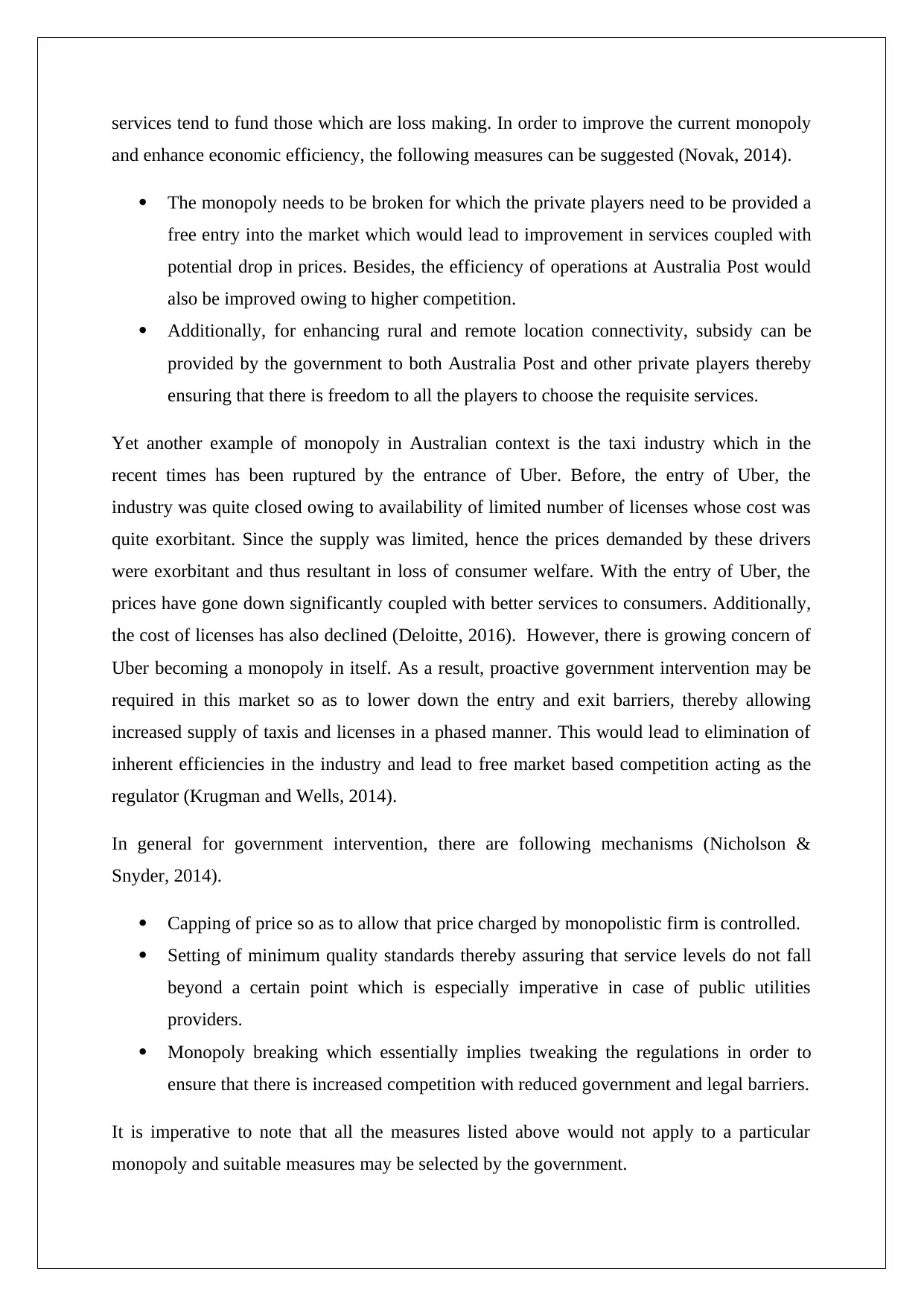
services tend to fund those which are loss making. In order to improve the current monopoly
and enhance economic efficiency, the following measures can be suggested (Novak, 2014).
The monopoly needs to be broken for which the private players need to be provided a
free entry into the market which would lead to improvement in services coupled with
potential drop in prices. Besides, the efficiency of operations at Australia Post would
also be improved owing to higher competition.
Additionally, for enhancing rural and remote location connectivity, subsidy can be
provided by the government to both Australia Post and other private players thereby
ensuring that there is freedom to all the players to choose the requisite services.
Yet another example of monopoly in Australian context is the taxi industry which in the
recent times has been ruptured by the entrance of Uber. Before, the entry of Uber, the
industry was quite closed owing to availability of limited number of licenses whose cost was
quite exorbitant. Since the supply was limited, hence the prices demanded by these drivers
were exorbitant and thus resultant in loss of consumer welfare. With the entry of Uber, the
prices have gone down significantly coupled with better services to consumers. Additionally,
the cost of licenses has also declined (Deloitte, 2016). However, there is growing concern of
Uber becoming a monopoly in itself. As a result, proactive government intervention may be
required in this market so as to lower down the entry and exit barriers, thereby allowing
increased supply of taxis and licenses in a phased manner. This would lead to elimination of
inherent efficiencies in the industry and lead to free market based competition acting as the
regulator (Krugman and Wells, 2014).
In general for government intervention, there are following mechanisms (Nicholson &
Snyder, 2014).
Capping of price so as to allow that price charged by monopolistic firm is controlled.
Setting of minimum quality standards thereby assuring that service levels do not fall
beyond a certain point which is especially imperative in case of public utilities
providers.
Monopoly breaking which essentially implies tweaking the regulations in order to
ensure that there is increased competition with reduced government and legal barriers.
It is imperative to note that all the measures listed above would not apply to a particular
monopoly and suitable measures may be selected by the government.
and enhance economic efficiency, the following measures can be suggested (Novak, 2014).
The monopoly needs to be broken for which the private players need to be provided a
free entry into the market which would lead to improvement in services coupled with
potential drop in prices. Besides, the efficiency of operations at Australia Post would
also be improved owing to higher competition.
Additionally, for enhancing rural and remote location connectivity, subsidy can be
provided by the government to both Australia Post and other private players thereby
ensuring that there is freedom to all the players to choose the requisite services.
Yet another example of monopoly in Australian context is the taxi industry which in the
recent times has been ruptured by the entrance of Uber. Before, the entry of Uber, the
industry was quite closed owing to availability of limited number of licenses whose cost was
quite exorbitant. Since the supply was limited, hence the prices demanded by these drivers
were exorbitant and thus resultant in loss of consumer welfare. With the entry of Uber, the
prices have gone down significantly coupled with better services to consumers. Additionally,
the cost of licenses has also declined (Deloitte, 2016). However, there is growing concern of
Uber becoming a monopoly in itself. As a result, proactive government intervention may be
required in this market so as to lower down the entry and exit barriers, thereby allowing
increased supply of taxis and licenses in a phased manner. This would lead to elimination of
inherent efficiencies in the industry and lead to free market based competition acting as the
regulator (Krugman and Wells, 2014).
In general for government intervention, there are following mechanisms (Nicholson &
Snyder, 2014).
Capping of price so as to allow that price charged by monopolistic firm is controlled.
Setting of minimum quality standards thereby assuring that service levels do not fall
beyond a certain point which is especially imperative in case of public utilities
providers.
Monopoly breaking which essentially implies tweaking the regulations in order to
ensure that there is increased competition with reduced government and legal barriers.
It is imperative to note that all the measures listed above would not apply to a particular
monopoly and suitable measures may be selected by the government.
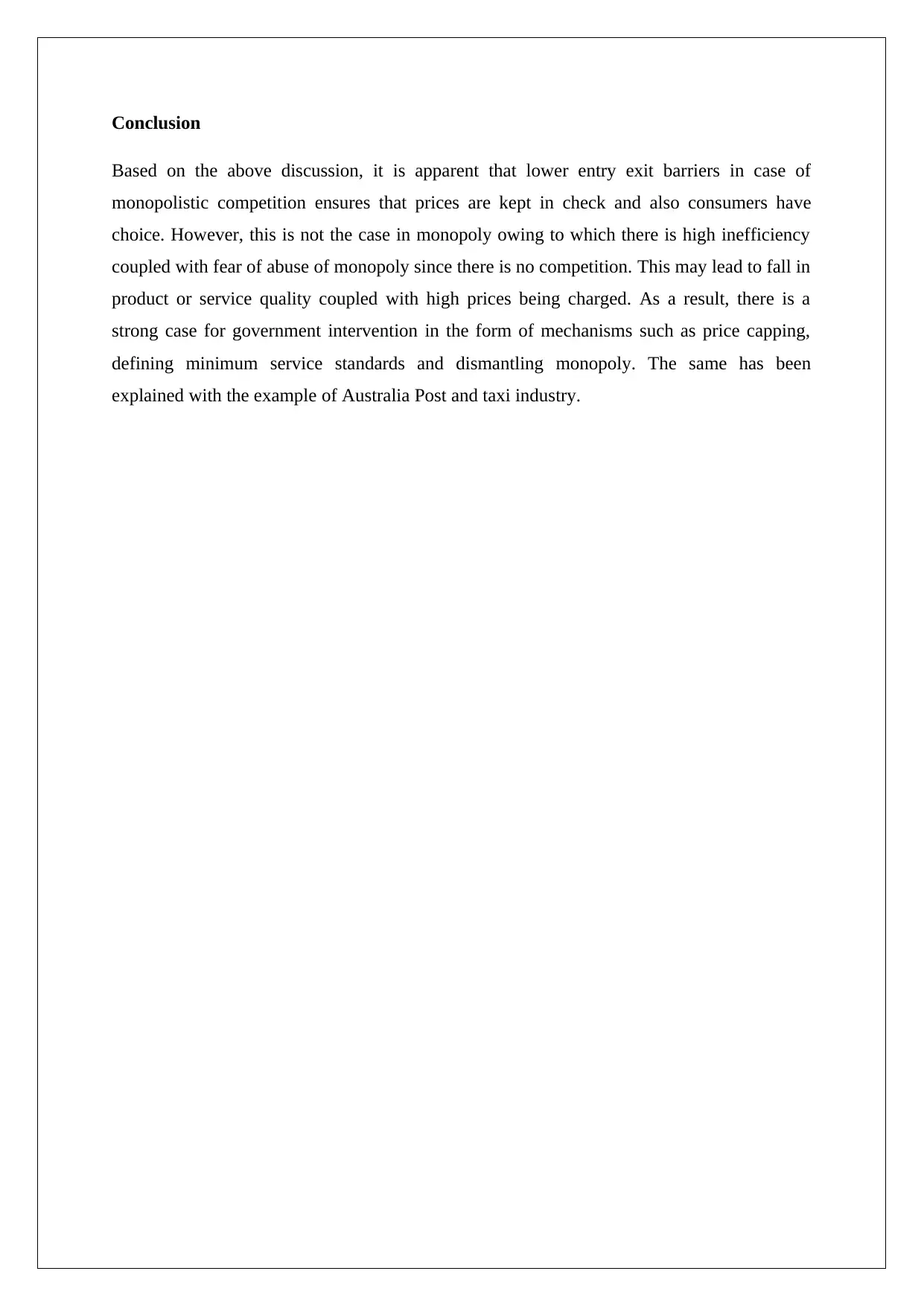
Conclusion
Based on the above discussion, it is apparent that lower entry exit barriers in case of
monopolistic competition ensures that prices are kept in check and also consumers have
choice. However, this is not the case in monopoly owing to which there is high inefficiency
coupled with fear of abuse of monopoly since there is no competition. This may lead to fall in
product or service quality coupled with high prices being charged. As a result, there is a
strong case for government intervention in the form of mechanisms such as price capping,
defining minimum service standards and dismantling monopoly. The same has been
explained with the example of Australia Post and taxi industry.
Based on the above discussion, it is apparent that lower entry exit barriers in case of
monopolistic competition ensures that prices are kept in check and also consumers have
choice. However, this is not the case in monopoly owing to which there is high inefficiency
coupled with fear of abuse of monopoly since there is no competition. This may lead to fall in
product or service quality coupled with high prices being charged. As a result, there is a
strong case for government intervention in the form of mechanisms such as price capping,
defining minimum service standards and dismantling monopoly. The same has been
explained with the example of Australia Post and taxi industry.
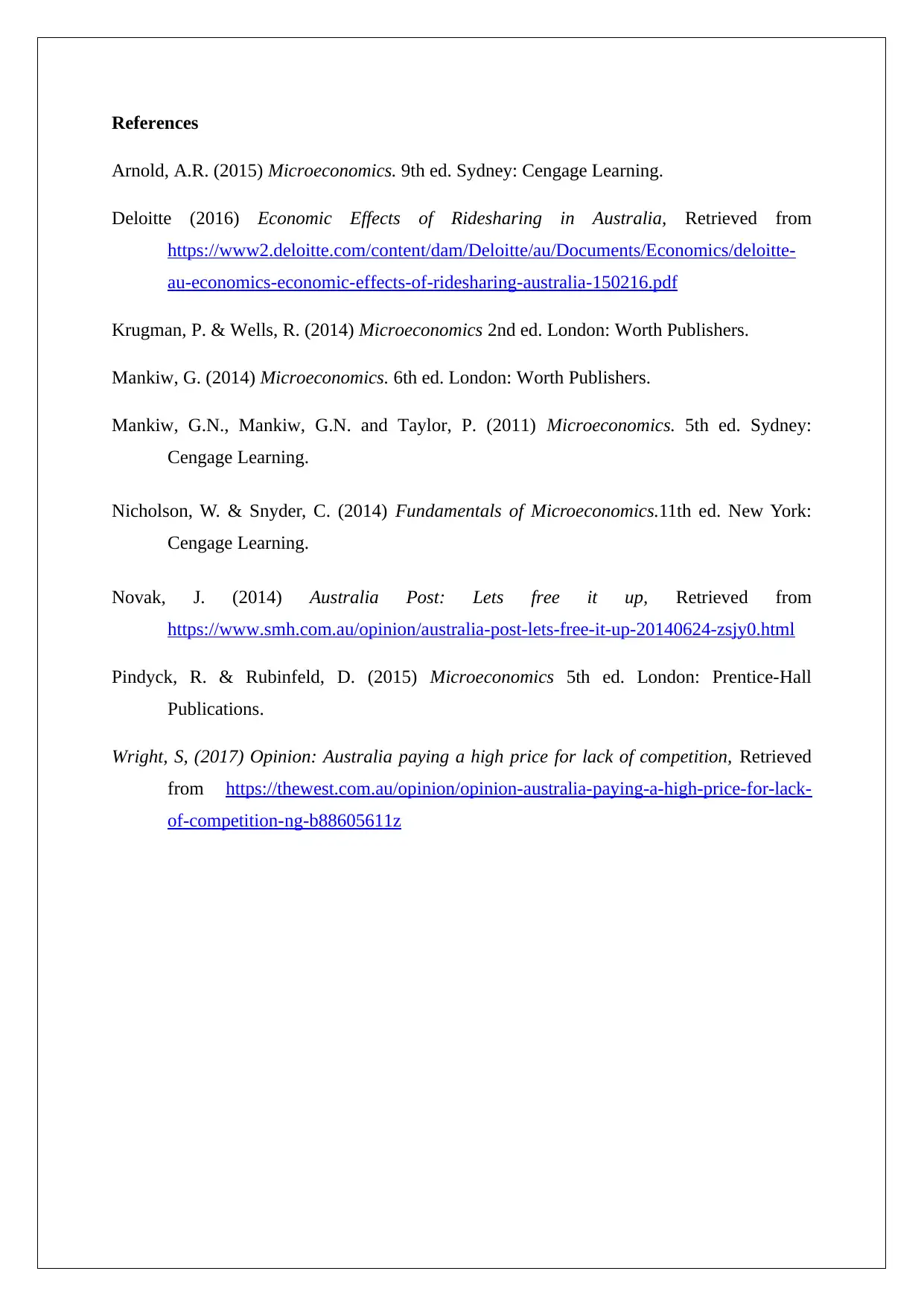
References
Arnold, A.R. (2015) Microeconomics. 9th ed. Sydney: Cengage Learning.
Deloitte (2016) Economic Effects of Ridesharing in Australia, Retrieved from
https://www2.deloitte.com/content/dam/Deloitte/au/Documents/Economics/deloitte-
au-economics-economic-effects-of-ridesharing-australia-150216.pdf
Krugman, P. & Wells, R. (2014) Microeconomics 2nd ed. London: Worth Publishers.
Mankiw, G. (2014) Microeconomics. 6th ed. London: Worth Publishers.
Mankiw, G.N., Mankiw, G.N. and Taylor, P. (2011) Microeconomics. 5th ed. Sydney:
Cengage Learning.
Nicholson, W. & Snyder, C. (2014) Fundamentals of Microeconomics.11th ed. New York:
Cengage Learning.
Novak, J. (2014) Australia Post: Lets free it up, Retrieved from
https://www.smh.com.au/opinion/australia-post-lets-free-it-up-20140624-zsjy0.html
Pindyck, R. & Rubinfeld, D. (2015) Microeconomics 5th ed. London: Prentice-Hall
Publications.
Wright, S, (2017) Opinion: Australia paying a high price for lack of competition, Retrieved
from https://thewest.com.au/opinion/opinion-australia-paying-a-high-price-for-lack-
of-competition-ng-b88605611z
Arnold, A.R. (2015) Microeconomics. 9th ed. Sydney: Cengage Learning.
Deloitte (2016) Economic Effects of Ridesharing in Australia, Retrieved from
https://www2.deloitte.com/content/dam/Deloitte/au/Documents/Economics/deloitte-
au-economics-economic-effects-of-ridesharing-australia-150216.pdf
Krugman, P. & Wells, R. (2014) Microeconomics 2nd ed. London: Worth Publishers.
Mankiw, G. (2014) Microeconomics. 6th ed. London: Worth Publishers.
Mankiw, G.N., Mankiw, G.N. and Taylor, P. (2011) Microeconomics. 5th ed. Sydney:
Cengage Learning.
Nicholson, W. & Snyder, C. (2014) Fundamentals of Microeconomics.11th ed. New York:
Cengage Learning.
Novak, J. (2014) Australia Post: Lets free it up, Retrieved from
https://www.smh.com.au/opinion/australia-post-lets-free-it-up-20140624-zsjy0.html
Pindyck, R. & Rubinfeld, D. (2015) Microeconomics 5th ed. London: Prentice-Hall
Publications.
Wright, S, (2017) Opinion: Australia paying a high price for lack of competition, Retrieved
from https://thewest.com.au/opinion/opinion-australia-paying-a-high-price-for-lack-
of-competition-ng-b88605611z
1 out of 10
Related Documents
Your All-in-One AI-Powered Toolkit for Academic Success.
+13062052269
info@desklib.com
Available 24*7 on WhatsApp / Email
![[object Object]](/_next/static/media/star-bottom.7253800d.svg)
Unlock your academic potential
© 2024 | Zucol Services PVT LTD | All rights reserved.





